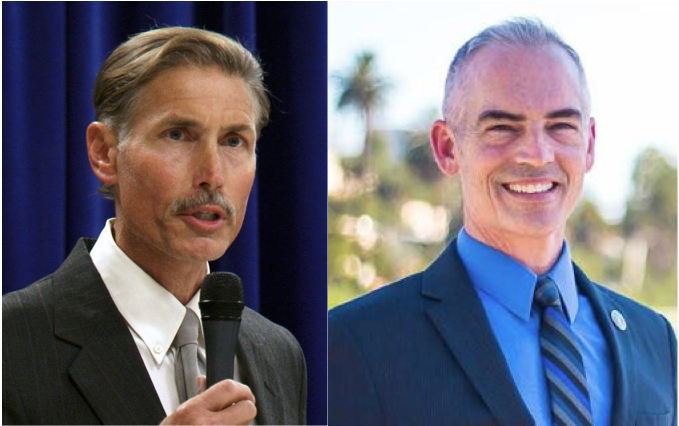Holy Moly, Batman! Hundreds Flock to CD 1 Debate at Sotomayor
EASTSIDER-A crowd of somewhere between four and six hundred people showed up at the first Council District 1 debate, held at the Sotomayor Learning Academies. My best guess is there were about 450. That’s a lot of people. And on a Thursday evening. Wow!
Hats off to the group who put this event together: The Glassell Park Improvement Association, with co-sponsorship from the Glassell Park Neighborhood Council, Mt. Washington Homeowners Alliance, Arroyo Arts Collective, Uptown Gay and Lesbian Alliance, LAUSD, Historic Cultural Neighborhood Council, Arroyo Seco Neighborhood Council, Echo Park Neighborhood Council and the North East Youth Council. Oversight was provided by the League of Women Voters, and the moderator was Univision’s own Gabriela Teissier.
This was a great example of what can happen when a community gets together at the grassroots level to do actually do something. There were a lot more people attending this event than the debate between Jose Huizar and Gloria Molina a few years ago. And the 2015 Huizar/Molina debate was co-sponsored by Cal State LA, the Pat Brown Institute, the League of Women Voters, and Eyewitness News Channel 7 -- so let’s hear it for our community.
The Candidates
 Who are these four candidates? Unless you’ve been living under a rock, you know that the incumbent is Gil Cedillo. You may even remember his epic knock-down-drag-out battle with Ed Reyes’ Chief Deputy, Jose Gardea, over replacing the termed out Reyes. A couple of million bucks and a runoff later, Gil won.
Who are these four candidates? Unless you’ve been living under a rock, you know that the incumbent is Gil Cedillo. You may even remember his epic knock-down-drag-out battle with Ed Reyes’ Chief Deputy, Jose Gardea, over replacing the termed out Reyes. A couple of million bucks and a runoff later, Gil won.
Readers of this column know Joe Bray-Ali from my recent article in CityWatch, “Get Ready for a Fight In CD1: Joe Bray-Ali Cleans Up Nice!”
Joe has moved far beyond his original, contentious bicycle lane revolution and is garnering support from environmental groups, small business owners (he owns his own bike shop), and various constituencies feeling left out by the incumbent.
Jesse Rosas has been running for office in Northeast LA for a while. In fact, during the last election, he got 7% of the vote and caused the runoff between Gil Cedillo and Jose Gardea. Originally from Mexico City, he’s been very active in Highland Park politics for years. A product of our school system (LAUSD at Belmont High, and then LACC), Jesse is a businessman and is running as such, to get the community the attention we deserve. You can find out more here.
Giovany Hernandez is by far the youngest candidate for office, and shows the hallmarks of an up and comer. Born and raised in the Pico Union slice of CD1, he graduated from UC Santa Cruz and has worked for SEIU, both as an organizer and signing up community members for Obamacare.
Currently he’s a parent organizer for the CCSA (California Charter Schools Association). You can find more about him here.
The Debate Questions
This was a very obstreperous crowd, often loud and rooting for their candidate. Given these circumstances, the League and moderator Gabriela Tessier (Univision) did a great job in maintaining order and making sure that each candidate got equal time for the questions.
I won’t get into too much detail on the responses -- this column would be way too long. Suffice it to say there were 13 questions in all, bookmarked by opening and closing statements, which is a lot of questions. It was nice that these questions came from the community, and here’s my best recollection of what they were. (After all, I can only take notes so fast.)
-How long have you lived in CD1?
-Given the number of homeless, how do you propose to help them in CD1?
-What’s your position on Measure S (the Neighborhood Integrity Initiative)?
-What’s your position on Rent Control for residents of CD1?
-How do you feel about Open Space and Development in CD1?
-How about small businesses, Community Plans and Neighborhood Councils in CD1?
-What’s your position on local arts, theater groups, and preservation in CD1?
-How about keeping CD1 clean?
-What’s your position on green energy, solar, and the DWP?
-How do you feel about crime and public safety in CD1?
-What issues are important for the LAUSD, even though the Council isn’t directly involved?
-What about transit issues in the District?
-How about the Figueroa St. corridor and bike lanes?
Sifting Through the Answers
It was evident that each of the candidates brought their supporters to the event. Of interest to me were the number of students attending. I assume this was because of Giovany and more particularly, our representative on the LAUSD Board (District 5), Ref Rodriguez. He was kind enough to provide the auditorium at Sotomayor Learning Academies for the event. Political junkies will remember that Ref, backed by the CCSA Charter folks, unseated incumbent Bennett Kayser in the last LAUSD Board election.
Anyhow, themes emerged as the candidates answered each of the questions. Gil Cedillo was clearly the professional politician at the height of his powers; he had done his homework in giving detailed specifics for each question based on his record in office. He repeatedly made a valid point that it’s easy to say what you will do when running for office, but it’s a different matter to actually legislate in the City Hall environment. He did not go into the 15-0 voting system of the Council.
In the overall area of Planning, I was very surprised that the only candidate openly supporting Measure S was Jesse Rosas. For me, that was a large disappointment. As many CityWatch articles have detailed, I believe that absent the passage of Measure S, the candidates are all just “blowin’ smoke” when it comes to effecting any change in the City’s development process. I can only assume that the multi-million dollar “No on S” campaign waged by the developers and their cronies is having an impact on voters.
Joe Bray-Ali shined when it came to small business, bikes, open space, and the environment and he has the endorsements to back it up. I have no doubt that he’s the real deal and is much more community-based than the incumbent. And while his bike lane buddies were wildly enthusiastic, they were much better behaved than during the bike wars.
To me, the biggest surprise of the evening was Giovany Hernandez. He was bright, energetic, well spoken, and clearly lives, works and plays in CD1. Not to mention that Pico Union has not had anyone from the community be successful in politics that I can remember. He was hell on wheels when it came to rent control, and was the only candidate to deal up front with gentrification. The youth crowd (students & Charter) were clearly in his camp, and he should have a promising future.
Jesse Rosas was motivated when it came to crime and public safety, and he was less politically correct and more direct than the other candidates about a police/business/town hall approach to involving the community in policing. Since he is intimately involved in the Figueroa St. corridor and the tragic deaths which have occurred there, this was not surprising. The other candidates were more nuanced, but in fairness, this issue is extremely complicated and way beyond the scope of a 13 question candidate forum.
The Takeaway
Let’s be honest. The odds are in favor of Gil Cedillo being re-elected. He’s endorsed by the entire LA City establishment, from Mayor Garcetti to the Parke Skelton (now rebranded as SG&A Consultants) stable of insiders, with all their money and clout. Heck, I even received a Local 1014 Firefighters Union endorsement sticker for Gil, although I don’t know how many firefighters actually live in CD1.
Most important, this election gives the winner 5 1/2 years in office. That’s right, a one-time only deal. I will never underestimate an incumbent with that level of security on the line.
I must also note that over the years Gil has taken a lot of heat for his very real concerns for our immigrant communities, helping out Dreamers and legislating driver’s licenses for the undocumented, when neither of these stands were popular. I know for a fact that his passion for these issues is genuine and I respect him for that. And he’s been knowledgeably pro-union in an environment where saying that get’s folks like my friend Jack Humphreville all revved up about bankrupting the City.
At the same time, on the PLUM Committee he has never met a developer that he doesn’t love, just like the rest of City Hall and the Mayor.
It also seemed pretty clear from the crowd’s reaction that there is a significant chunk of the electorate who are not in love with Mr. Cedillo.
If I were betting, of all the other candidates, Joe Bray-Ali stands the best chance of getting in to a runoff. He has an innovative Facebook & social media campaign going, which allows him to leverage limited resources in a manner that reminds me of Bernie’s Presidential campaign, and I suspect that the same generational change may be happening here. Surprisingly, he also has the endorsement of the LA Times.
Giovany Hernandez is a wild card. He did very well with the crowd and his answers were specific to the questions and on point. While his public campaign seems limited, I will never underestimate what the CCSA can do by pouring large sums of money into an election. Just ask Bennett Kayser.
My best guess is that Jesse Rosas will get about the same percentage as last time. He’s a decent person, but absent any real donor base and/or ground game, this is simply too competitive a race for him to stay in the hunt.
All in all the real winner in this debate were the members of our community, and everyone and every organization who participated deserves a great big “well done!” I have never seen all our various community groups work together like this. Such a huge crowd size on a school night was awesome.
So do your bit -- VOTE! Who knows, we could see that rarity in LA politics…a runoff.
(Tony Butka is an Eastside community activist, who has served on a neighborhood council, has a background in government and is a contributor to CityWatch.) Edited for CityWatch by Linda Abrams.










 Fortunately, Rising, 75, has some reassuring answers about today’s California, as I learned during two recent long conversations. And if you’re a reader who doesn’t know the name Nelson Rising, don’t worry—that’s the point. Nelson Rising’s story is about all the big things you can get done in California if you’re willing to listen more than you talk. Over the years his impressive accomplishments have spoken for themselves, without much ballyhoo for the man himself.
Fortunately, Rising, 75, has some reassuring answers about today’s California, as I learned during two recent long conversations. And if you’re a reader who doesn’t know the name Nelson Rising, don’t worry—that’s the point. Nelson Rising’s story is about all the big things you can get done in California if you’re willing to listen more than you talk. Over the years his impressive accomplishments have spoken for themselves, without much ballyhoo for the man himself.

 They project that LA County could suffer a potential three-year loss of 800,000 international visitors as a direct result of President Trump’s Executive Orders. These visitors typically spend $920 each while in LA, totaling a potential loss of $736 million in direct tourism spending.
They project that LA County could suffer a potential three-year loss of 800,000 international visitors as a direct result of President Trump’s Executive Orders. These visitors typically spend $920 each while in LA, totaling a potential loss of $736 million in direct tourism spending. 


 Stay Off Our Lawn! California officials thereby have concluded that the state cannot be compelled to use its police or military forces for law enforcement purposes; in their analysis, controlling immigration is a federal responsibility, not a matter for state or local law enforcement.
Stay Off Our Lawn! California officials thereby have concluded that the state cannot be compelled to use its police or military forces for law enforcement purposes; in their analysis, controlling immigration is a federal responsibility, not a matter for state or local law enforcement.




 It’s a mess and Ryu (speaking to MMRA meeting photo left) is right in the middle of it. The ground has suddenly shifted from the original dispute about HPOZ boundaries -- that were reset in December by David Ambroz and the Central Planning Commission -- to Ryu now asking the very basic question, “who wants a Miracle Mile HPOZ?” Results of Ryu’s poll will be revealed at a community meeting he has called for February 22, at 7p.m. in the auditorium of John Burroughs Middle School. Both the Miracle Mile Residential Association and Say No HPOZ are mobilizing for what could be a showdown with Ryu, who is now in a tough position.
It’s a mess and Ryu (speaking to MMRA meeting photo left) is right in the middle of it. The ground has suddenly shifted from the original dispute about HPOZ boundaries -- that were reset in December by David Ambroz and the Central Planning Commission -- to Ryu now asking the very basic question, “who wants a Miracle Mile HPOZ?” Results of Ryu’s poll will be revealed at a community meeting he has called for February 22, at 7p.m. in the auditorium of John Burroughs Middle School. Both the Miracle Mile Residential Association and Say No HPOZ are mobilizing for what could be a showdown with Ryu, who is now in a tough position. 
 First, it is obviously important that Indivisible grows in number. It's standard to compare organizational strength to the National Rifle Association. They should make it a goal to grow to at least that size. But it's also important that the resistance to Trump's policies continue to grow outside of the big cities on the two coasts. Therefore, people who are willing to join the opposition should reach out to people who live in political border areas, the places that the news media traditionally refers to as purple (for their near balance of liberals and conservatives). Whether it's relatives or old classmates, online chums or army buddies, it's important for participants to make the effort to bring in at least one or two new people.
First, it is obviously important that Indivisible grows in number. It's standard to compare organizational strength to the National Rifle Association. They should make it a goal to grow to at least that size. But it's also important that the resistance to Trump's policies continue to grow outside of the big cities on the two coasts. Therefore, people who are willing to join the opposition should reach out to people who live in political border areas, the places that the news media traditionally refers to as purple (for their near balance of liberals and conservatives). Whether it's relatives or old classmates, online chums or army buddies, it's important for participants to make the effort to bring in at least one or two new people. 
















